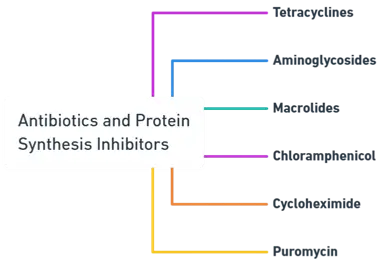- Inhibitors of Translation, the process of protein synthesis from mRNA, can be inhibited by various compounds that target specific components or stages of this process.
- These inhibitors are crucial in research for elucidating mechanisms of translation and serve as valuable antibiotics in medicine.

Advertisements
However, their potential toxicity to eukaryotic cells necessitates careful management of their use.
1. Tetracyclines
- Target: Small ribosomal subunit in prokaryotes.
- Mechanism: Prevent the binding of aminoacyl-tRNA to the A site of the ribosome, inhibiting protein synthesis.
- Use: Treat bacterial infections.
- Examples: Tetracycline antibiotics.
2. Aminoglycosides
- Target: Small ribosomal subunit in prokaryotes.
- Mechanism: Cause misreading of mRNA, leading to the production of faulty proteins.
- Use: Treat various bacterial infections.
- Examples: Streptomycin, neomycin.
Advertisements
3. Macrolides
- Target: Large ribosomal subunit in prokaryotes.
- Mechanism: Block the exit tunnel for the growing polypeptide chain, inhibiting protein synthesis.
- Use: Treat bacterial infections, especially those caused by Gram-positive bacteria.
- Examples: Erythromycin, azithromycin.
4. Chloramphenicol
- Target: Large ribosomal subunit in prokaryotes.
- Mechanism: Inhibits peptidyl transferase activity, preventing peptide bond formation.
- Use: Treat a variety of bacterial infections, with cautious use due to potential side effects.
- Examples: Chloramphenicol.
Advertisements
5. Cycloheximide
- Target: Large ribosomal subunit in eukaryotes.
- Mechanism: Blocks the translocation step of translation.
- Use: Research tool to study protein synthesis in eukaryotic cells, not used therapeutically due to toxicity.
- Examples: Cycloheximide.
6. Puromycin
- Target: Affects both prokaryotic and eukaryotic ribosomes.
- Mechanism: Resembles the 3′ end of an aminoacyl-tRNA and causes premature termination of translation by being incorporated into the growing polypeptide chain.
- Use: Research tool not typically used therapeutically.
- Examples: Puromycin.
- These inhibitors play a critical role in both understanding the complex process of translation and providing therapeutic options against bacterial infections.
- Their diverse mechanisms of action reflect the complexity of the translation process and the potential for developing targeted therapies.
Click Here to Watch the Best Pharma Videos
Advertisements

